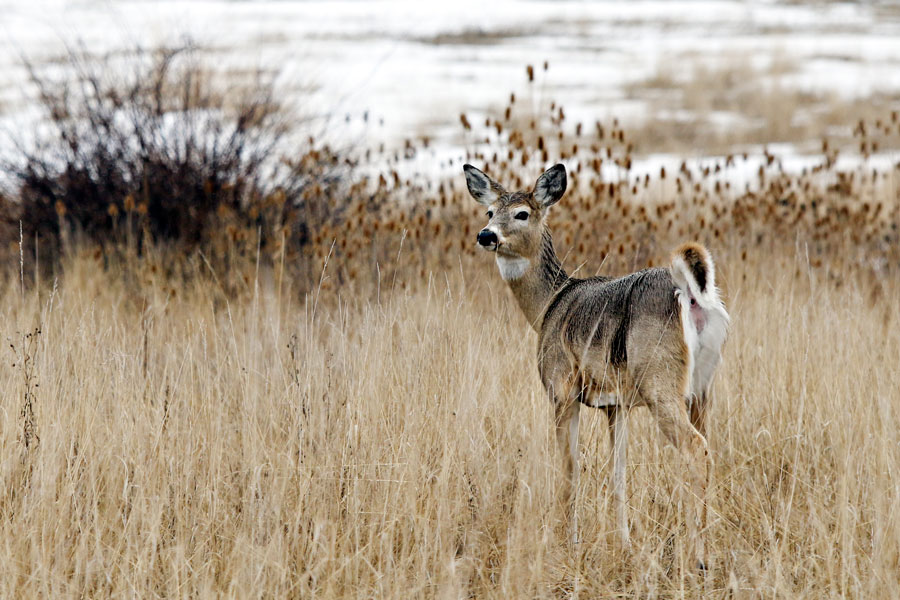Every autumn for 24 years, Kalispell resident and Backcountry Hunters & Anglers Board Chairman Ryan Busse has traveled to the wide-open spaces of Northern Montana’s Hi-Line to hunt, where few people reside and healthy wild game populations roam.
He’s scaled the entire remote Hi-Line in search of deer, elk and antelope, but he’s recently started pursuing game elsewhere after Montana Fish, Wildlife and Parks (FWP) detected Chronic Wasting Disease (CWD), a fatal disease that affects deer, elk and moose, in 2017.
Busse doesn’t want to worry about encountering an infected animal, whose symptoms could include zombie-like characteristics such as drooling, stumbling, excessive thirst and a lack of coordination. So he’s sticking to areas without a known CWD presence. FWP also requires hunters to stop at check stations to test their game for CWD presence, a hassle that Busse avoids by hunting in areas where the disease is not present.
Since Busse is spending less time in the north-central part of the state, he’s also taking his money elsewhere. Over the last two decades-plus, he’s stayed in hotels from Cut Bank just east of the Blackfeet Indian Reservation all the way to Glasgow in the plains of Eastern Montana. He and his hunting partners have eaten at numerous local restaurants, stocked up on supplies at local businesses and dropped by local bars.
Busse’s reluctance to hunt in a CWD-prevalent area reflects some other hunters’ attitudes toward the disease, which is slowly spreading across Montana.
“Different states have been experiencing this,” Montana Office of Outdoor Recreation Director Rachel VandeVoort said. “The spread and the existence of this disease is not only in Montana, but across the country, and has the potential for massive ramifications. You have direct dollars from hunters’ spending money in local hotels, eating meals and spending on sporting gear.”
In 2018, FWP detected 23 positive mule deer (2% prevalence) and three positive white-tailed deer (1% prevalence) along the Hi-Line, ranging from Shelby to Culbertson. This caused FWP to add this area to their priority sampling area in 2019, along with southeastern Montana, the Philipsburg area and the Libby area.
After surveillance in Libby, FWP detected a 13.1% prevalence in Libby, within a 10-mile radius of downtown, and a 3.5% prevalence outside that radius, according to FWP Region 1 Wildlife Manager Neil Anderson.
Many people are impacted by what’s called CWD’s “ick factor.” Hunters are reluctant to fill their freezers with a CWD-infected animal, even though the Centers for Disease Control and Prevention (CDC) has no reported cases of CWD infection in humans through infected meat consumption. Still, while there is no evidence that CWD can infect humans, FWP does not recommend consuming infecting animals.
VandeVoort says that when hunters see a clearly diseased animal, they will probably ask themselves, “Do I really want to shoot that or eat that?”
Busse isn’t as concerned about human transmission since there aren’t any confirmed cases, but that future possibility scares him.
“If that ever is verified, then I think we’re in a whole new sphere of worry,” Busse said.
VandeVoort is concerned that CWD will impact the already declining participation in hunting, which may have even broader and more long-term consequences on the country’s public lands.
Wildlife conservation is also significantly funded through excise taxes on firearms, ammunition and archery equipment. VandeVoort is concerned how these long-term effects will impact public lands since the North American Model of Conservation is funded by hunters and anglers. Fewer opportunities mean fewer license sales, fewer gear purchases and less money that’s cycled back into fish and game management, she said.
Declining participation worries Busse, too.
“If CWD degrades our experiences (on public lands), it represents a potential dire consequence for Americans and how they respect and value public lands,” Busse said.
With the CWD prevalence below 5% in Montana, Anderson says it hasn’t caused much impact on populations yet, but as the disease spreads, FWP could issue more licenses in Region 1 in an effort to reduce the density.
In Libby, the densities are mostly confined to the urban areas, and FWP officials want to reduce the herd’s likelihood of migrating.
“There’s not a whole lot of tools in the toolbox for managing CWD,” Anderson said. “If we have areas like we do in Libby where we have this pocket of CWD, (we) reduce densities and keep it from spreading and slow it down.”
While FWP continues to manage CWD and its spread, some hunters in Montana are already altering their hunting habits with different locations, and Busse worries about what that means for future generations of hunters.
“My largest fear is not the reporting and the social stigma — I’m worried about herd health (and) how it will dictate hunter participation,” Busse said. “If there are less deer and elk or less healthy deer and elk, that’ll mean less opportunities … We’ll hunt less.”
